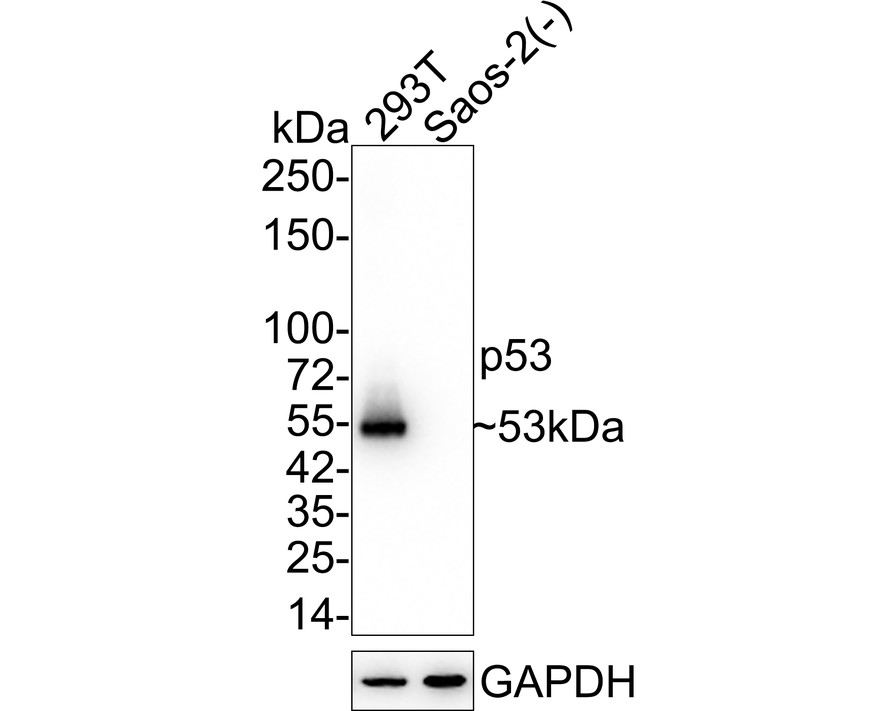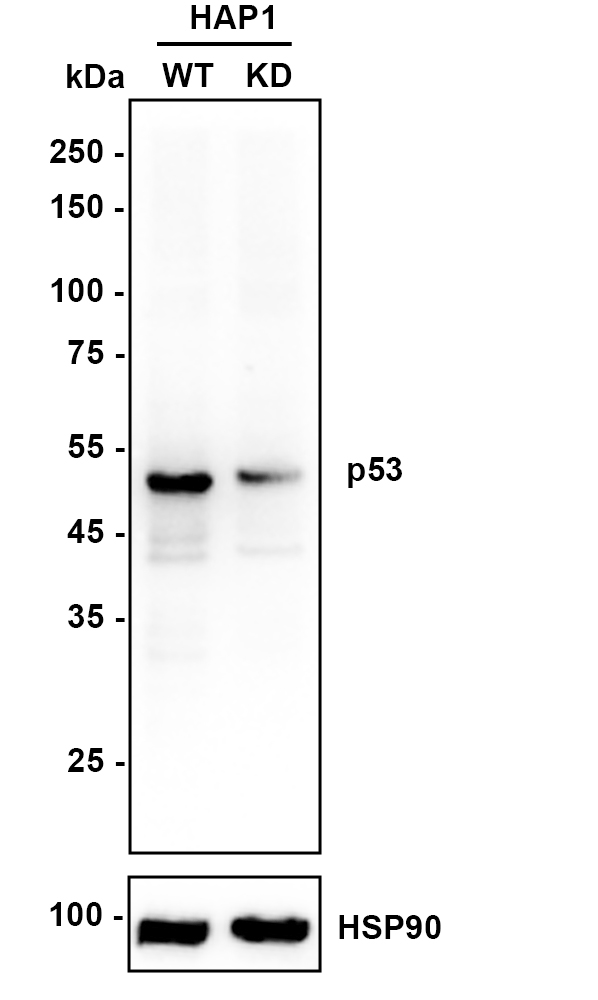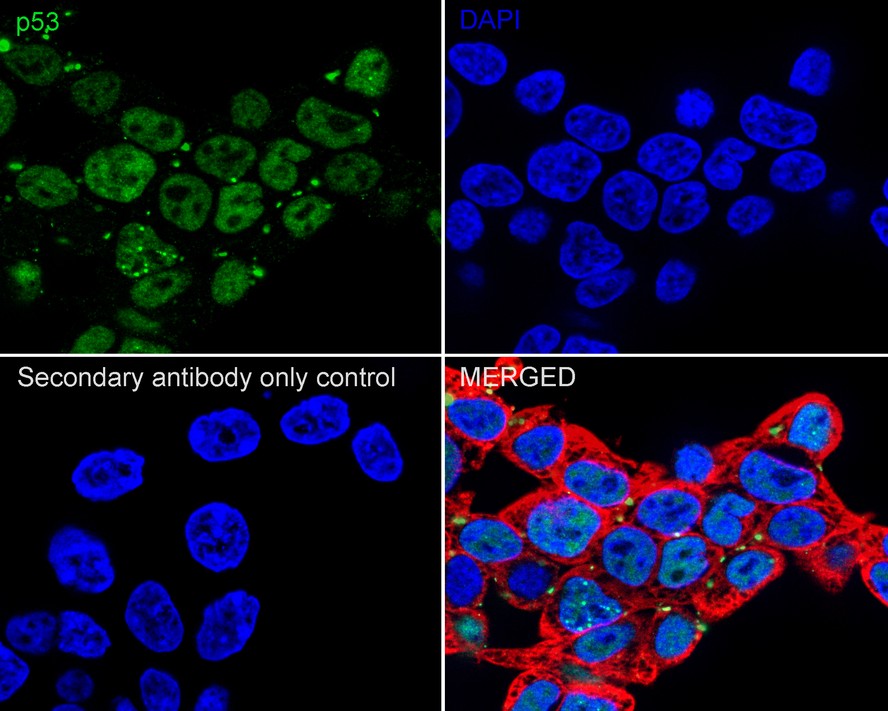p53 Recombinant Rabbit Monoclonal Antibody [SA39-07]

cat.: ET1601-13
| Product Type: | Recombinant Rabbit monoclonal IgG, primary antibodies |
|---|---|
| Species reactivity: | Human |
| Applications: | WB, IF-Cell, ChIP |
| Clonality: | Monoclonal |
| Clone number: | SA39-07 |
| Form: | Liquid |
| Storage condition: | Shipped at 4℃. Store at +4℃ short term (1-2 weeks). It is recommended to aliquot into single-use upon delivery. Store at -20℃ long term. |
| Storage buffer: | 1*TBS (pH7.4), 0.05% BSA, 40% Glycerol. Preservative: 0.05% Sodium Azide. |
| Concentration: | 1ug/ul |
| Purification: | Protein A affinity purified. |
| Molecular weight: | Predicted band size: 53 kDa |
| Isotype: | IgG |
| Immunogen: | Recombinant protein within human p53 aa 1-100. |
| Positive control: | 293T cell lysate, 293T. |
| Subcellular location: | Cytoplasm, Nucleus, Endoplasmic reticulum, Mitochondrion matrix |
| Recommended Dilutions:
WB IF-Cell ChIP |
1:5,000 1:400 Use 0.5~2 μg for 25 μg of chromatin. |
| Uniprot #: | SwissProt: P04637 Human |
| Alternative names: | Antigen NY-CO-13 BCC7 Cellular tumor antigen p53 FLJ92943 LFS1 Mutant tumor protein 53 p53 p53 tumor suppressor P53_HUMAN Phosphoprotein p53 Tp53 Transformation related protein 53 TRP53 Tumor protein 53 Tumor protein p53 Tumor suppressor p53 |
Images

|
Fig1:
Western blot analysis of p53 on different lysates with Rabbit anti-p53 antibody (ET1601-13) at 1/5,000 dilution. Lane 1: 293T cell lysate Lane 2: Saos-2 cell lysate (negative) Lysates/proteins at 20 µg/Lane. Predicted band size: 53 kDa Observed band size: 53 kDa Exposure time: 43 seconds; ECL: K1801; 4-20% SDS-PAGE gel. Proteins were transferred to a PVDF membrane and blocked with 5% NFDM/TBST for 1 hour at room temperature. The primary antibody (ET1601-13) at 1/5,000 dilution was used in 5% NFDM/TBST at room temperature for 2 hours. Goat Anti-Rabbit IgG - HRP Secondary Antibody (HA1001) at 1/50,000 dilution was used for 1 hour at room temperature. |

|
Fig2:
Western blot analysis of p53 on different lysates with Rabbit anti-p53 antibody (ET1601-13) at 1/5,000 dilution. Lane 1: HAP1-parental cell lysate Lane 2: HAP1-p53 KD cell lysate Lysates/proteins at 10 µg/Lane. Predicted band size: 53 kDa Observed band size: 53 kDa Exposure time: 6 seconds; ECL: K1801; 4-20% SDS-PAGE gel. Proteins were transferred to a PVDF membrane and blocked with 5% NFDM/TBST for 1 hour at room temperature. The primary antibody (ET1601-13) at 1/5,000 dilution was used in primary antibody dilution (K1803) at 4℃ overnight. Goat Anti-Rabbit IgG - HRP Secondary Antibody (HA1001) at 1/50,000 dilution was used for 1 hour at room temperature. |

|
Fig3:
Immunocytochemistry analysis of 293T cells labeling p53 with Rabbit anti-p53 antibody (ET1601-13) at 1/400 dilution. Cells were fixed in 4% paraformaldehyde for 20 minutes at room temperature, permeabilized with 0.1% Triton X-100 in PBS for 5 minutes at room temperature, then blocked with 1% BSA in 10% negative goat serum for 1 hour at room temperature. Cells were then incubated with Rabbit anti-p53 antibody (ET1601-13) at 1/400 dilution in 1% BSA in PBST overnight at 4 ℃. Goat Anti-Rabbit IgG H&L (iFluor™ 488, HA1121) was used as the secondary antibody at 1/1,000 dilution. PBS instead of the primary antibody was used as the secondary antibody only control. Nuclear DNA was labelled in blue with DAPI. Beta tubulin (M1305-2, red) was stained at 1/100 dilution overnight at +4℃. Goat Anti-Mouse IgG H&L (iFluor™ 594, HA1126) was used as the secondary antibody at 1/1,000 dilution. |

|
Fig4: Chromatin immunoprecipitations were performed with cross-linked chromatin from HCT 116 treated with UV for 40minutes then recover for 3 hours cells with p53 (ET1601-13) or Normal Rabbit IgG according to the ChIP protocol. The enriched DNA was quantified by real-time PCR using indicated primers. The amount of immunoprecipitated DNA in each sample is represented as signal relative to the total amount of input chromatin, which is equivalent to one. |
Note: All products are “FOR RESEARCH USE ONLY AND ARE NOT INTENDED FOR DIAGNOSTIC OR THERAPEUTIC USE”.